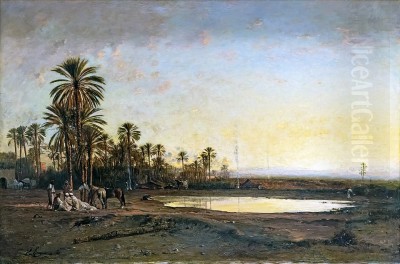
Victor Pierre Huguet (1835-1902) stands as a notable figure within the rich tapestry of 19th-century French art. He dedicated his career primarily to Orientalism, a genre that captivated European audiences with its depictions of North Africa and the Middle East. Huguet's canvases are celebrated for their vibrant portrayal of landscapes, bustling street scenes, and the daily life of regions that were, to many Europeans of his time, lands of mystery and allure. His work reflects both meticulous observation gained through extensive travel and a distinct artistic sensibility that evolved throughout his career.
Early Life and Artistic Formation
Born in 1835 in Le Lude, Sarthe, France, Victor Pierre Huguet embarked on his artistic journey relatively early. His formal training began not in the capital, but in the major port city of Marseille, at the École Supérieure des Beaux-Arts. Marseille's strong maritime connections with North Africa may have played a role in sparking his initial interest in the Orient. Seeking to further hone his skills, Huguet later moved to Paris, the undisputed center of the European art world.
A pivotal moment in his artistic development was his tutelage under Eugène Fromentin (1820-1876). Fromentin was himself a highly respected painter and writer, renowned for his sensitive and atmospheric depictions of Algeria. Studying with Fromentin provided Huguet with invaluable technical guidance and likely deepened his commitment to the Orientalist genre, exposing him to the established conventions and possibilities of depicting these specific locales. This mentorship placed Huguet within a direct lineage of French Orientalist painting.
The Call of the Orient: Travels and Inspirations
Huguet's fascination with the East was not merely academic; it was fueled by direct experience. In 1852, at the young age of seventeen, he undertook his first significant journey, traveling to Egypt. This early exposure to the unique light, landscapes, and culture of the Nile Valley left an indelible mark on his artistic vision. It was the beginning of a lifelong engagement with the region.
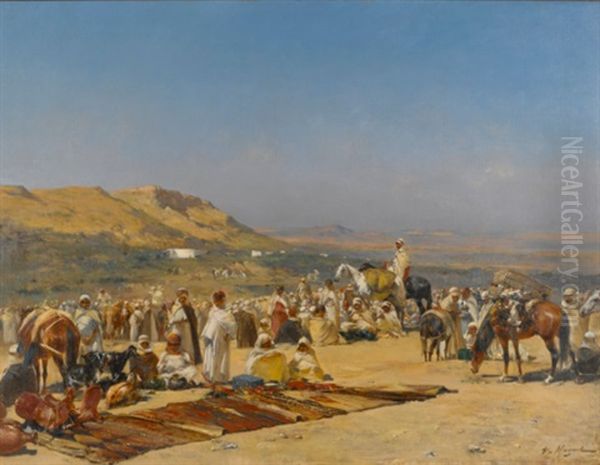
Following his initial Egyptian voyage, Huguet's wanderlust took him to other parts of North Africa and the Ottoman Empire. His itineraries included extensive travels in Algeria, a primary source of inspiration for many French Orientalists, as well as Libya and Constantinople (modern-day Istanbul). Some accounts suggest he may have also visited Tunisia and participated in an expedition related to the Crimean War (1853-1856), though his fame rests firmly on his peaceful scenes of daily life and landscapes. These journeys were essential, providing him with sketches, studies, and vivid memories that formed the raw material for his paintings created back in his French studio.
Capturing the Exotic: Artistic Style and Themes
Victor Pierre Huguet worked firmly within the Orientalist tradition, focusing on subjects that evoked the atmosphere and perceived exoticism of the lands he visited. His canvases often feature vibrant marketplaces teeming with activity, nomadic encampments under wide desert skies, caravans of camels traversing sandy dunes, horsemen engaged in hunts or displays of skill, and tranquil scenes set in oases or near ancient ruins. He possessed a keen eye for architectural details and the textures of local crafts and clothing.
His style, while rooted in the academic realism prevalent in the mid-19th century, showed signs of evolution. Influenced perhaps by his teacher Fromentin, his earlier works demonstrate careful drawing and composition. However, over time, particularly in his later career, Huguet's palette noticeably brightened. His use of color became richer and more luminous, capturing the intense sunlight of North Africa. Some art historians note a move towards a more painterly technique, with looser brushwork, suggesting an awareness of, if not a full conversion to, the burgeoning Impressionist movement happening concurrently in Paris. His skill in depicting animals, particularly the horses and camels central to many of his scenes, was widely acknowledged.
Signature Canvases: Representative Works
While a comprehensive catalogue raisonné might be complex, several works are frequently cited as representative of Huguet's oeuvre and themes. Among these are:
Camels and Figures Resting in the Desert (circa 1860): This title evokes a classic Orientalist scene, likely depicting a caravan pausing during its journey, showcasing Huguet's ability to render both the animals and the vastness of the desert landscape under a strong light.
Street scene with figures: A recurring theme, these works capture the energy and social interactions of urban life in North African or Middle Eastern towns. They allowed Huguet to depict diverse characters, colorful attire, and architectural settings.
Hunt with Falcons: Falconry was a subject favored by Orientalist painters, suggesting nobility, tradition, and skill. A painting with this title would likely feature Arab horsemen with birds of prey, set against a dramatic landscape, combining action with exotic detail.
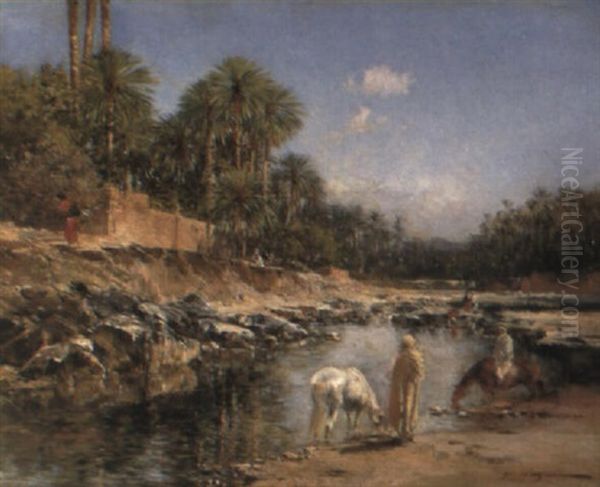
Resting Place or Watering Place: Often depicting oases or riverbanks, these paintings offered a contrast to the harshness of the desert, focusing on moments of tranquility, the reflection of light on water, and the gathering of people and animals.
Market in the Desert: Similar to street scenes but often set in more open, perhaps temporary, locations, these works allowed for depictions of trade, nomadic life, and the vibrant exchange of goods under the desert sun.
These titles reflect the core subjects that Huguet returned to throughout his career, demonstrating his sustained interest in capturing the landscapes and human activities of the regions he explored.
A Recognized Talent: Career and Recognition
Victor Pierre Huguet achieved considerable recognition during his lifetime. He began exhibiting his work professionally in 1859, showing his paintings in both Paris and his former training ground, Marseille. His regular participation in the official Paris Salon, the most important art exhibition in France at the time, brought his work to the attention of critics, collectors, and the public.
His standing within the specialized field of Orientalism was solidified in 1893 when he became a member of the prestigious Société des Peintres Orientalistes Français (Society of French Orientalist Painters). This membership placed him among the leading practitioners of the genre. Further evidence of his success comes from the fact that his works were acquired by several French museums, indicating official approbation. His paintings also appeared in international exhibitions, such as one noted at the Buffalo Fine Arts Academy in the United States. Huguet's work continues to be sought after, appearing regularly at major auction houses like Bonhams and achieving significant prices, demonstrating its enduring appeal to collectors.
Huguet in the Parisian Art World: Contemporaries and Context
To fully appreciate Victor Pierre Huguet's career, it's essential to place him within the dynamic art world of 19th-century Paris. His most direct artistic lineage connects back to his teacher, Eugène Fromentin. He was also a contemporary of other major figures in French Orientalism, whose works he would certainly have known and exhibited alongside. These include the highly detailed and often dramatic painter Jean-Léon Gérôme, the earlier Romantic pioneer Eugène Delacroix, as well as Alexandre-Gabriel Decamps, Léon Belly, Gustave Guillaumet, the Italian Orientalist Alberto Pasini (who worked extensively for a French audience), and Benjamin-Constant.
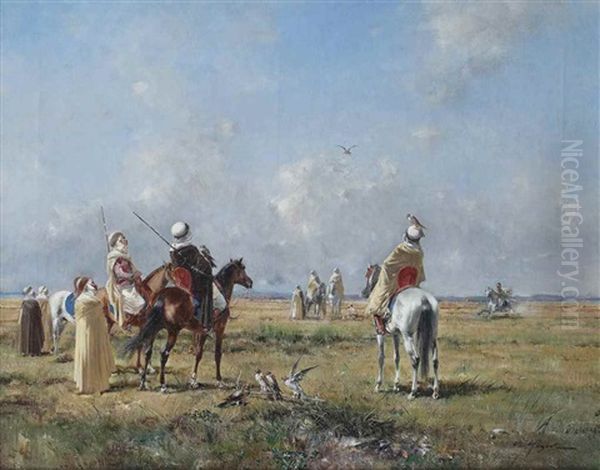
Beyond the Orientalist circle, Huguet's career unfolded during a period of immense artistic ferment. The established Academic tradition, upheld by painters like William-Adolphe Bouguereau and Alexandre Cabanel, still dominated the official Salons. Simultaneously, the revolutionary movement of Impressionism was taking shape and challenging artistic conventions. While Huguet's style retained a degree of realism distinct from Impressionism, he worked in the same city and era as Claude Monet, Pierre-Auguste Renoir, Edgar Degas, Camille Pissarro, Berthe Morisot, and Alfred Sisley. Although no records confirm direct personal interaction between Huguet and the core Impressionist group, his later adoption of a brighter palette might reflect a subtle awareness of their groundbreaking experiments with light and color that permeated the Parisian art scene.
Orientalism: Fascination and Scrutiny
Victor Pierre Huguet was a key participant in the Orientalist movement, a phenomenon deeply intertwined with 19th-century European culture. Fueled by colonial expansion, increased travel, archaeological discoveries, and a Romantic fascination with the "exotic," Orientalism satisfied a public hunger for images of distant, often idealized or misunderstood, lands. Huguet's paintings, with their depictions of vibrant souks, desert vistas, and traditional life, catered directly to this interest.
However, from the late 20th century onwards, Orientalism as a genre has faced significant critical scrutiny, largely influenced by Edward Said's seminal work. Critics argue that Orientalist art often relied on stereotypes, presenting the East as inherently sensual, primitive, unchanging, or dangerous. It has been critiqued for potentially reinforcing colonial attitudes by depicting Eastern cultures through a Western lens, emphasizing difference and sometimes overlooking the complexities and realities of the societies portrayed. Issues of cultural appropriation and the power imbalance inherent in Western artists representing Eastern subjects are also central to this critique. While Huguet's work is often admired for its aesthetic qualities and observational detail, it inevitably exists within this broader, complex historical and critical context. There are no records of specific major controversies surrounding Huguet himself, but his work, like that of his contemporaries, participates in the broader discourse and debates surrounding Orientalism.
Enduring Visions: Legacy and Art Historical Significance
Victor Pierre Huguet's legacy lies in his contribution to French Orientalist painting. He was a skilled and prolific artist who successfully captured the light, atmosphere, and specific character of the North African and Middle Eastern landscapes and cultures that inspired him. His work provided a European audience with vivid, albeit interpreted, glimpses into these regions during a period of intense Western interest.
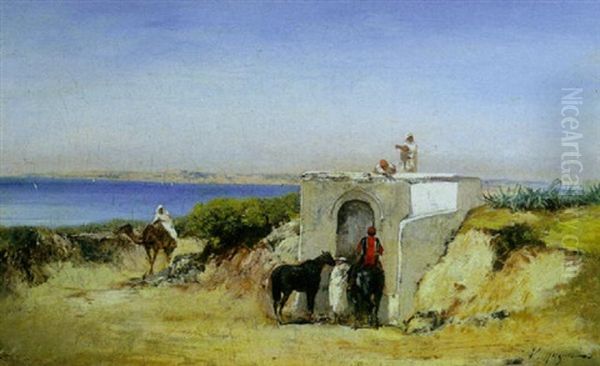
He stands as a significant representative of the second generation of Orientalist painters, building upon the foundations laid by artists like Delacroix and Decamps, and working alongside contemporaries like Gérôme and his own teacher, Fromentin. His ability to render detailed scenes, combined with an increasingly luminous palette later in his career, ensured his popularity during his lifetime and his continued recognition in the art market today. His paintings remain valuable both for their artistic merit and as historical documents reflecting the particular vision of the "Orient" prevalent in 19th-century Europe.
Conclusion
Victor Pierre Huguet remains an important figure for anyone studying 19th-century French art, particularly the Orientalist movement. Through extensive travel and dedicated practice, he developed a distinctive style characterized by careful observation, a sensitivity to light and atmosphere, and a focus on the landscapes and daily life of North Africa and the Middle East. His paintings, exhibited widely and collected by museums and private individuals, continue to evoke the allure and fascination these regions held for European audiences of his time, securing his place as a master of the Orientalist genre.